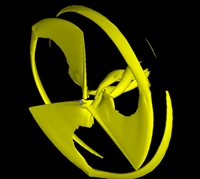 ROTOR computations: The EllipSys3D code has during the last years been used for very detailed calculations of the entire flow field around a wind turbine rotor. Up to 20.0 million grid points are used to capture the most important flow features. Calculations have been validated against experimental data, and looking at streamlines, pressure fields, or any other parameter a very detailed picture of the flow field is given, leading to important physical understanding of the flow.
ROTOR computations: The EllipSys3D code has during the last years been used for very detailed calculations of the entire flow field around a wind turbine rotor. Up to 20.0 million grid points are used to capture the most important flow features. Calculations have been validated against experimental data, and looking at streamlines, pressure fields, or any other parameter a very detailed picture of the flow field is given, leading to important physical understanding of the flow.
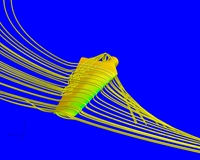
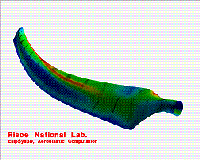 Aeroelastic Stability: Fully coupled aeroelastic computations requires the computational mesh to deform with the geometry, and requires comprehensive time true computations. In the present project the aeroelastic problem is solved using the EllipSys3D Navier-Stokes solver to computed the aerodynamics and the HAWC aeroelastic solver to compute the structural dynamics. Additionally the codes can be used in a decoupled mode, using the Navier-Stokes solver to computed the damping of mode shapes predicted by the structural solver.
Aeroelastic Stability: Fully coupled aeroelastic computations requires the computational mesh to deform with the geometry, and requires comprehensive time true computations. In the present project the aeroelastic problem is solved using the EllipSys3D Navier-Stokes solver to computed the aerodynamics and the HAWC aeroelastic solver to compute the structural dynamics. Additionally the codes can be used in a decoupled mode, using the Navier-Stokes solver to computed the damping of mode shapes predicted by the structural solver.
 Yaw simulation: The aerodynamics of rotors under skewed inflow are important in connection with load predictions for real wind turbines. The aerodynamics are extremely complex, as seen from the iso-vorticity plots of the wake behind the rotor. The agreement with measured data at the mid span of the rotor shows excellent agreement with measured data.
Yaw simulation: The aerodynamics of rotors under skewed inflow are important in connection with load predictions for real wind turbines. The aerodynamics are extremely complex, as seen from the iso-vorticity plots of the wake behind the rotor. The agreement with measured data at the mid span of the rotor shows excellent agreement with measured data.

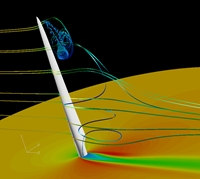 Stand Still: The problems connected to standstill operation has been investigated. To validate the code for this application, drag computations of flat plates are performed. The code show excellent agreement with measurements for these cases.
Stand Still: The problems connected to standstill operation has been investigated. To validate the code for this application, drag computations of flat plates are performed. The code show excellent agreement with measurements for these cases.
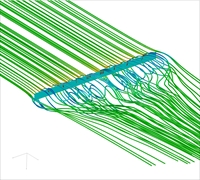
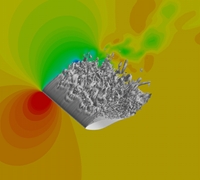 Advanced turbulence modelling is also investigated. It is well known that standard Reynolds Averaged Navier-Stokes (RANS) models do not work in highly separated flows. To try and alleviate this, so called Detached Eddy Simulation (DES) techniques are used. These models are hybrids of RANS and Large Eddy Simulation models. Below computation of a axial flow through a two-bladed rotor is shown, while DES computation around an airfoilsection is shown to the right.
Advanced turbulence modelling is also investigated. It is well known that standard Reynolds Averaged Navier-Stokes (RANS) models do not work in highly separated flows. To try and alleviate this, so called Detached Eddy Simulation (DES) techniques are used. These models are hybrids of RANS and Large Eddy Simulation models. Below computation of a axial flow through a two-bladed rotor is shown, while DES computation around an airfoilsection is shown to the right.
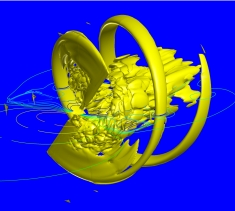
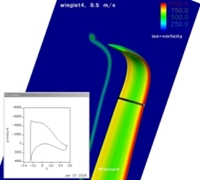 Tip and root region analysis: Recently various tip- and winglet shapes have been analysed using EllipSys3D. Also various blade root design and the effect of the spinner shape has been investigated.
Tip and root region analysis: Recently various tip- and winglet shapes have been analysed using EllipSys3D. Also various blade root design and the effect of the spinner shape has been investigated.
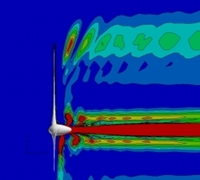
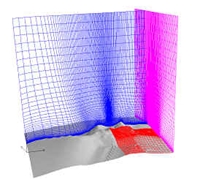 PhD. studies: Currently two Ph.D studies are being carried out. They are "Application of Overset Grids in CFD for studying the rotor/tower interaction" by Frederik Zahle and "Modelling of Atmospheric Boundary Layer using hybrid RANS/LES turbulence modelling" by Andreas Hansen.
PhD. studies: Currently two Ph.D studies are being carried out. They are "Application of Overset Grids in CFD for studying the rotor/tower interaction" by Frederik Zahle and "Modelling of Atmospheric Boundary Layer using hybrid RANS/LES turbulence modelling" by Andreas Hansen.
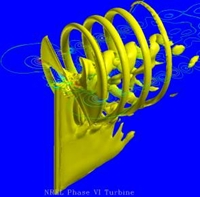
Airfoil design: The EllipSys2D code has been coupled to an in-house optimisation design code and series of specific wind turbine airfoils have been designed for both pitch regulated, stall regulated, and active stall regulated wind turbines.
Double stall: Using the CFD code EllipSys2D a thorough investigation of transition point location was carried out. Results indicated that moving the transition point slightly could change the separation on the airfoil leading to a total change in airfoil characteristics. This indicated that airfoils sensitive to transition could have undesirable stall characteristics during certain operational conditions.